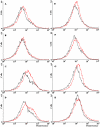A MATE-family efflux pump rescues the Escherichia coli 8-oxoguanine-repair-deficient mutator phenotype and protects against H(2)O(2) killing
- PMID: 20463878
- PMCID: PMC2865507
- DOI: 10.1371/journal.pgen.1000931
A MATE-family efflux pump rescues the Escherichia coli 8-oxoguanine-repair-deficient mutator phenotype and protects against H(2)O(2) killing
Abstract
Hypermutation may accelerate bacterial evolution in the short-term. In the long-term, however, hypermutators (cells with an increased rate of mutation) can be expected to be at a disadvantage due to the accumulation of deleterious mutations. Therefore, in theory, hypermutators are doomed to extinction unless they compensate the elevated mutational burden (deleterious load). Different mechanisms capable of restoring a low mutation rate to hypermutators have been proposed. By choosing an 8-oxoguanine-repair-deficient (GO-deficient) Escherichia coli strain as a hypermutator model, we investigated the existence of genes able to rescue the hypermutable phenotype by multicopy suppression. Using an in vivo-generated mini-MudII4042 genomic library and a mutator screen, we obtained chromosomal fragments that decrease the rate of mutation in a mutT-deficient strain. Analysis of a selected clone showed that the expression of NorM is responsible for the decreased mutation rate in 8-oxoguanine-repair-deficient (mutT, mutY, and mutM mutY) strains. NorM is a member of the multidrug and toxin extrusion (MATE) family of efflux pumps whose role in E. coli cell physiology remains unknown. Our results indicate that NorM may act as a GO-system backup decreasing AT to CG and GC to TA transversions. In addition, the ability of NorM to reduce the level of intracellular reactive oxygen species (ROS) in a GO-deficient strain and protect the cell from oxidative stress, including protein carbonylation, suggests that it can extrude specific molecules-byproducts of bacterial metabolism-that oxidize the guanine present in both DNA and nucleotide pools. Altogether, our results indicate that NorM protects the cell from specific ROS when the GO system cannot cope with the damage.
Conflict of interest statement
The authors have declared that no competing interests exist.
Figures





Similar articles
-
Adenine Glycosylase MutY of Corynebacterium pseudotuberculosis presents the antimutator phenotype and evidences of glycosylase/AP lyase activity in vitro.Infect Genet Evol. 2016 Oct;44:318-329. doi: 10.1016/j.meegid.2016.07.028. Epub 2016 Jul 22. Infect Genet Evol. 2016. PMID: 27456281
-
Interactions among the Escherichia coli mutT, mutM, and mutY damage prevention pathways.DNA Repair (Amst). 2003 Feb 3;2(2):159-73. doi: 10.1016/s1568-7864(02)00193-3. DNA Repair (Amst). 2003. PMID: 12531387
-
Evidence that MutY and MutM combine to prevent mutations by an oxidatively damaged form of guanine in DNA.Proc Natl Acad Sci U S A. 1992 Aug 1;89(15):7022-5. doi: 10.1073/pnas.89.15.7022. Proc Natl Acad Sci U S A. 1992. PMID: 1495996 Free PMC article.
-
Repair of 8-oxo-7,8-dihydroguanine in prokaryotic and eukaryotic cells: Properties and biological roles of the Fpg and OGG1 DNA N-glycosylases.Free Radic Biol Med. 2017 Jun;107:179-201. doi: 10.1016/j.freeradbiomed.2016.11.042. Epub 2016 Nov 27. Free Radic Biol Med. 2017. PMID: 27903453 Review.
-
Multiple DNA glycosylases for repair of 8-oxoguanine and their potential in vivo functions.Prog Nucleic Acid Res Mol Biol. 2001;68:193-205. doi: 10.1016/s0079-6603(01)68100-5. Prog Nucleic Acid Res Mol Biol. 2001. PMID: 11554297 Review.
Cited by
-
Bacterial Multidrug Efflux Pumps at the Frontline of Antimicrobial Resistance: An Overview.Antibiotics (Basel). 2022 Apr 13;11(4):520. doi: 10.3390/antibiotics11040520. Antibiotics (Basel). 2022. PMID: 35453271 Free PMC article. Review.
-
Normal mutation rate variants arise in a Mutator (Mut S) Escherichia coli population.PLoS One. 2013 Sep 12;8(9):e72963. doi: 10.1371/journal.pone.0072963. eCollection 2013. PLoS One. 2013. PMID: 24069167 Free PMC article.
-
The Evolutionary Conservation of Escherichia coli Drug Efflux Pumps Supports Physiological Functions.J Bacteriol. 2020 Oct 22;202(22):e00367-20. doi: 10.1128/JB.00367-20. Print 2020 Oct 22. J Bacteriol. 2020. PMID: 32839176 Free PMC article. Review.
-
Role of bacterial multidrug efflux pumps during infection.World J Microbiol Biotechnol. 2024 Jun 1;40(7):226. doi: 10.1007/s11274-024-04042-7. World J Microbiol Biotechnol. 2024. PMID: 38822187 Review.
-
Oxidative DNA damage is instrumental in hyperreplication stress-induced inviability of Escherichia coli.Nucleic Acids Res. 2014 Dec 1;42(21):13228-41. doi: 10.1093/nar/gku1149. Epub 2014 Nov 11. Nucleic Acids Res. 2014. PMID: 25389264 Free PMC article.
References
-
- Modrich P, Lahue R. Mismatch repair in replication fidelity, genetic recombination, and cancer biology. Annu Rev Biochem. 1996;65:101–133. - PubMed
-
- Friedberg E, Walker G, Seide W, Wood R, Schultz R, et al. DNA Repair and Mutagenesis. Washington DC, USA: American Society of Microbiology; 2006.
-
- Cheng KC, Cahill DS, Kasai H, Nishimura S, Loeb LA. 8-Hydroxyguanine, an abundant form of oxidative DNA damage, causes G-T and A-C substitutions. J Biol Chem. 1992;267:166–172. - PubMed
Publication types
MeSH terms
Substances
LinkOut - more resources
Full Text Sources
Molecular Biology Databases
Research Materials
Miscellaneous

